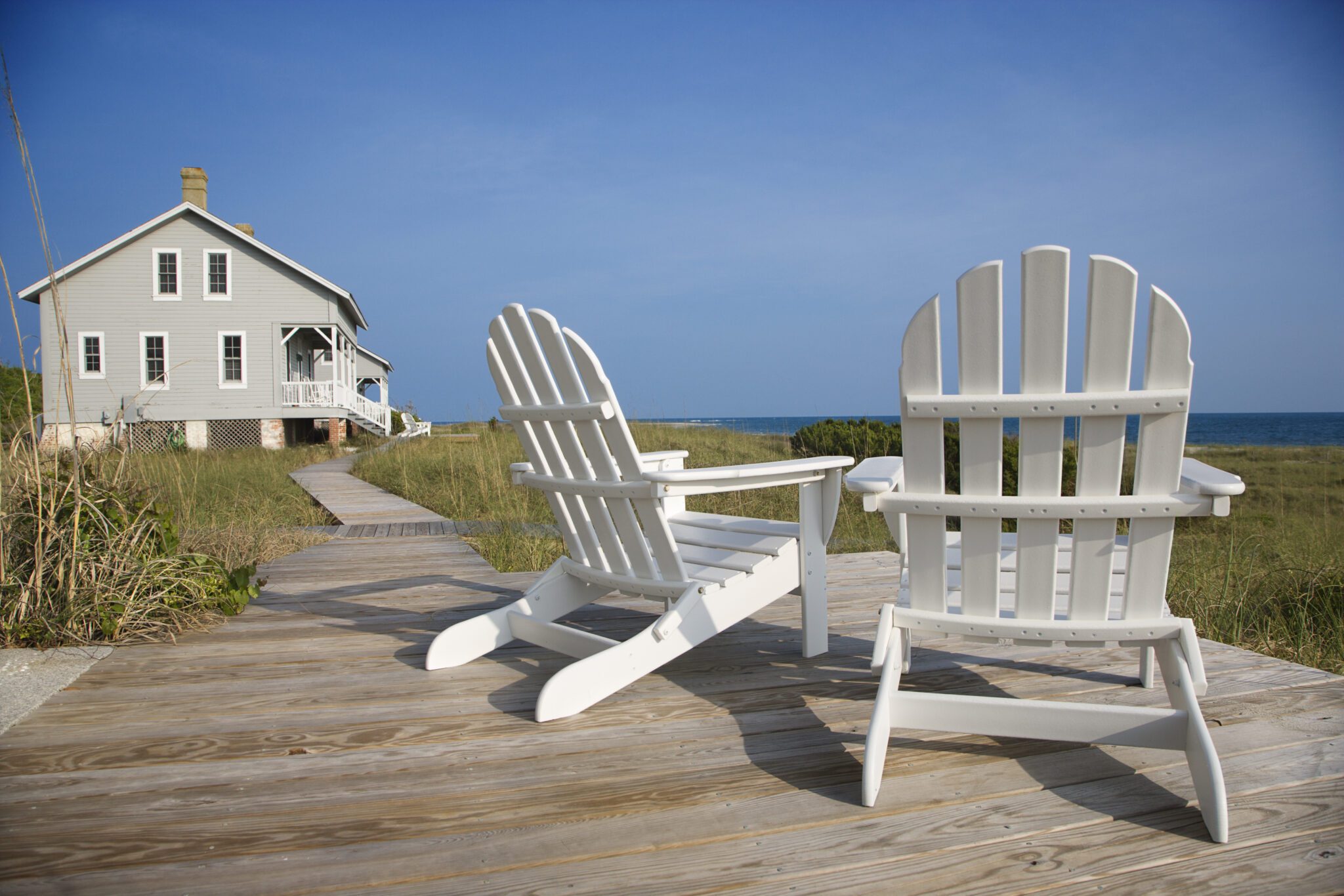
It’s no exaggeration to say every family going on vacation at some point has had an “Oh no!” moment. Ours was a few years ago around 5:00 AM in the pouring down rain as we were getting ready to head out for spring break. The night before we were so organized; we rented a Thule cargo carrier, had it professionally installed on our car, proceeded to pack it with way too much luggage and had everything locked and ready with the vehicle parked just outside of the garage.
We were headed to the long-time family home in Old Naples, Florida to see Grammy and Bop. Our alarm went off at 4:30 AM and as I went to wake the kids my husband went out to warm up the car. I realized it was raining and ran to the garage to tell him to move the car closer to the house because it was a classic, cold, midwestern March rain.
My husband was so excited to get to Naples he was just thinking about sitting on the beach and decided it made more sense to pull the car in the garage and not closer to the garage – forgetting the Thule was bolted to the top of the car. The kids and I walked out ready for SPRING BREAK!! WOOT! only to find a shredded and bent Thule and our bags soaked from the pouring rain.
As a family we had a choice – postpone or cancel the trip and get the Thule fixed, or we could make do. There was no way to fit all the bags inside our car and the Thule was professionally bolted to the roof (remember how organized and responsible we were in getting it professionally installed the day before?). So my husband grabbed a bright blue tarp we kept for raking leaves and some straps. We wrapped the Thule in the tarp, secured it with the tie downs and were on our way!
The ride was horrible, the wind going through the tarp made a loud whooshing sound, the tie downs flapped against our windows, and I had visions of all our clothes flying out and landing all over the highway. On top of that, every time we pulled into a gas station, we all wanted to hide. Our car looked like something from National Lampoon’s Vacation with the bright blue tarp, which progressively became shredded and torn as our road trip continued.
But that evening around 9:00 we hit Gulf Shore Boulevard in Old Naples, we rolled down our windows to the warm ocean breeze and the sound of the ocean. With our shredded Thule we pulled into the driveway of Grammy and Bop’s house. They were waiting by the front door in the dark, the kids ran out of the car as fast as the could to hug their grandparents.
Bop passed away in 2020. Looking back now, I am so glad we didn’t cancel our trip. We can never get that time together back. The trip that destroyed our Thule taught our kids two important lessons: nothing should stop you from precious time with family, and it’s always good to find humor in difficult times.
Family vacation homes have emotional meaning beyond anything words can explain. A house on the beach, by a lake, or a cabin in the woods — they can become one of the most cherished family assets. Family vacation homes represent parents, grandparents, family, cousins, aunts and uncles, and friends. They bring people together in ways we can’t experience any other way.
The homes hold memoires of final trips with people who are no longer with us. They have an ability to enrich relationships, provide new experiences, create opportunities to spend time with cousins, and provide peace and comfort.
Today families with significant wealth can become isolated from each other because they have large, comfortable homes, multiple cars to drive separately to destinations and even private air travel. The family vacation home transcends all of this and brings us back to a place of togetherness, to the past, and sometimes, like our Thule adventure, a place of shared frustration.
The emotions of the sights, smells and memories of the family vacation home help define the family culture. The home becomes so much more than a piece of property, it becomes part of the family itself.
Creating a family vacation home statement.
Because of the significant emotional ties, as the family ages and changes there are few family assets which can create conflicts and family arguments like the family vacation home. To avoid conflict over the shared family vacation home, which can be a launch for conflict into other family business ventures and other assets, families should establish a statement for the family property that provides a framework for how it will be used amongst the family members while also taking into consideration succession plans for future generations.

The family home statement is not a formal legal document, but rather one that is designed to provide guidance for how key decisions will be made in regard to the property, including how to manage conflicts, pay expenses, schedule visits, ensure the safety of guests and the family, as well as planning for the future.
Title and ownership (whether it’s held in an LLC, an irrevocable trust, or tenants-in-common) also needs to be addressed. If the property has been in the family for several generations, the deed to the property should be pulled to ensure it is titled correctly
What happens often, as I’ve seen with many different families, is that the smallest details are the ones that cause the biggest conflicts. I’ve seen one family fall into conflict over a family member wanting new knobs on the kitchen cabinets, to another family having conflict over someone who always wanted the best week out of the year to use the home, or how non-perishable food items should be stored, and even if the vacation home should include a television and cable.
As the family develops its vision for the long-term goals of the property and how it aligns with the overall wealth planning goals, the most important aspect of the family statement is to simply do one.
What to include.
The family statement should include how decisions will be made and how conflicts will be resolved — does the family want decisions made by simple majority, super majority, or a combination of the two where different levels of majority are required for bigger, more expensive projects or other key issues? Do different generations have different voting rights?
We all know maintaining vacation homes can be expensive, and not all extended family members have the same means, or values as to when expenses should be incurred or how they should be paid. Before the family home statement is drafted, a list of all recurring expenses should be prepared. Next, a plan for how they will be paid and by whom should be fully documented. Once the expense plan is in place, it’s important to have an attorney look over this portion to make sure there are no gift tax issues.

Safety and security as well as usage should also be considered in the home statement. Are guests allowed? Parties? Is there a limit to how many people can be in the home? I’ve seen instances where some family members are comfortable with kids and teenagers sleeping on couches, but other family members want everyone on a bed.
How will the schedule be handled? With extended family and often cousins involved as well, scheduling can become difficult because everyone wants to use the home on the holidays. A plan for how holiday usage will be handled is very important. Rules for usage and safety with ATV’s, boats, jet skis and hunting equipment should be included as well. For example, what one family deems an appropriate age for an ATV driver, another may consider too young and unsafe.
Adding a succession plan to the family statement.
With a shared family vacation home, time spent walking with grandpa to the lake to get the boat ready, siblings working together to help open or winterize a cabin, building a sandcastle with grandma on the beach are all great ways to teach children teamwork, responsibility, conflict resolution and leadership.
The most difficult aspect of the family vacation home statement is the succession plan. At some point, the value of all the memories, lessons learned, and shared family struggles could be tested. Tests to the goals of succession can come in many forms, including:
- One family wanting out of the responsibility or expense.
- An unsolicited purchase offer on the home at or above market value.
- An older home in need of updates.
- One family wanting the home decorated in a certain way and another family not wanting an expense.
- A family with a new marriage or divorce.
- A family who moves away, or who has children no longer able to use the home.
- One family member wanting to rent the shared home to non-family members as an income stream.
For these reasons, if there is not a family statement on the purpose of the home and how succession should be handled, major conflicts can arise very easily.

Most families envision their shared vacation home to be in the family for generations and generations to come, but is there a price the family would sell? Many shared vacation homes are in valuable areas of the world where land does not come on the market often. If an unsolicited offer to purchase the home materialized, what is the price the family would sell?
What if expenses become too much? Will the home be rented? Sometimes one family moves across the country or to a different country and they no longer use the home. Is there a buyout plan, or is the goal to keep the home in the family no matter what happens?
If there is never a plan to sell, will the home be handed down from blood line or will spouses be included? Ensuring sure the home is properly titled and all corresponding legal documents, such as estate plans, are in line with the family statement is incredibly important as well.
Flexibility is the key to succession planning for a shared family vacation home. Since the home can be such a highly-emotional family asset, planning for flexibility so the needs of future generations can be addressed is vital.
A comprehensive succession plan provision that addresses the above items and others like them can go a long way to minimizing conflict and ensuring the home remains in the family for generations to come.
—-
In today’s world, it’s becoming increasingly difficult to provide younger generations the experience of working together, of how to resolve conflicts, and of being with and respecting older generations. The shared family vacation home fosters unique opportunities for building these values, along with providing cherished memories. The shared family home mission statement enables families to enhance the value of the home and ensure cohesiveness across current and future generations.
For us, years and years of going to the shared family vacation home was about going to see Grammy and Bop, spending time together as a family, interacting with cousins and friends, building sandcastles on the beach, hitting the waves, and swimming in the pool. We had our list of restaurants we always frequented, along with walking on the pier for sunsets, and of course, the local ice cream shop for those warm summer nights.
As a family, we had a difficult choice to make when we received an unsolicited offer on our home. Accepting it felt like losing someone in the family, losing part of the memories and times together with those no longer with us, and grieving for those future generations to come who would not have the same experiences as our kids.

However, our mission statement for the shared family home guided us through this difficult time and helped us make a really tough decision, one not guided by the heartstrings and emotion of owning a home by the ocean. We emerged from the decision with a family intact, void of conflict, confidence in the decision we made, and memories we will carry with us forever. What greater legacy can grandparents leave than that?
Compardo, Wienstroer, Conrad & Janes has significant experience guiding multi-generational families through successful wealth transfers. Our staff of diverse professionals stays informed to help you make better financial decisions. We serve Family Office, Professional Athletes and Family CFO clients. You can visit our website here.
Compardo, Wienstroer, Conrad & Janes presents The Importance of Legacy Planning Series. is the third article in our five-part series.
- The Road to Preserving Multi-Generational Wealth
- Planning for the Shared Family Vacation home
- The Family Mission Statement
- How A Succession Plan Can Help Preserve Family Wealth
- Family Learning Programs
For media inquiries contact us here.
Anna McDonald joined Compardo, Wienstroer, Conrad & Janes at Moneta after spending almost six years as an ESPN reporter. She now serves a dual role utilizing both her sports background and education background. Anna educates and writes about the issues ultra-high net worth families’ face as they engage and prepare the rising generation for the wealth, roles and responsibilities they may inherit. Her education in child and family development and her prior work experience, where she developed learning programs for families, enable her to address the complex personal and family dynamics those with significant wealth face.
In her dual role, she also helps orchestrate the day-to-day financial needs our professional athlete clients have while also developing family learning strategies for ultra-high net worth families.
© 2021 Moneta Group Investment Advisors, LLC. All rights reserved. These materials were prepared for informational purposes only based on materials deemed reliable, but the accuracy of which has not been verified; trademarks and copyrights of materials linked herein are the property of their respective owners. This is not an offer to sell or buy securities, nor does it represent any specific recommendation. You should consult with an appropriately credentialed professional before making any financial, investment, tax or legal decision. Past performance is not indicative of future returns. These materials do not take into consideration your personal circumstances, financial or otherwise.



